Identification of bacterial fossils in marine source rocks in South China
2018-03-28BaojianShenJianzhongQinBorjiginTengerAnyangPanYunfengYangLizengBian
Baojian Shen•Jianzhong Qin•Borjigin Tenger•Anyang Pan•Yunfeng Yang•Lizeng Bian
1 Introduction
Bacteria,one of the earliest life forms on earth,evolved from single-celled creatures four billion years ago.From then on,bacteria and archaea dominated the biosphere for three billion years(Schopf 1994;Delong and Pace 2001).Bacterial fossil record,traced back to Archean and Proterozoic(Soudry and Champetier 1983;Glenn and Arthur 1988;Rao and Nai 1988;Soudry and Lewy 1988;Reimers et al.1996;West all 1999;Bailey et al.2007;Berndmeyer et al.2012;Arning et al.2009;Eric et al.2015),were very meaningful for exploring extraterrestrial life(Westall 1999).Some scholars suggested that bacterial fossils were usually widespread at the time when the global marine microorganisms exploded and the marine environment was reductive,and the high paleoproductivity of microorganisms and hypoxic environment created favorable conditions for the formation of marine source rocks(Yang et al.2007;Wang et al.2007).Particularly worth mentioning is the bacteria that is a critical source of sedimentary organic matter,and also a key type of parent materials in the process of hydrocarbon generation(Zhang and Lu 1993;Wang and Tao 2005).
The bacterial fossils were generally diagnosed in respect of morphology,size and texture,through the use of organic petrology,environmental scanning electron microscopy(ESEM)and transmission electron microscopy(TEM).Though Xie et al.(2013)and Zhang et al.(2015)had done some work on bacterial fossils in the Cambrian Niutitang Formation source rocks and sediments in Guizhou,research on bacterial fossils in the marine source rocks in South China remains rare,and this paper will focus on the identification of bacterial fossils in these excellent marine source rocks in different strata,potentially giving some hints on the genesis of the bacterial fossils.
2 Samples and experiments
2.1 Geological settings and samples
Sichuan basin and adjacent areas is one of the regions rich in natural gas.The explored geologic reserves in marine strata account for 70%of all geologic reserves in this region(Liu et al.2015).Weiyuan gas field and Puguang gas field were discovered in 1953 and 2001(Ma 2007;Ma et al.2010).With the breakthrough of shale gas exploration and development in Fuling area,it revealed a good exploration prospect of Paleozoic shale gas(Guo et al.2014),due to the abundant materials in this region—as one of most important factors.Current research results showed that there were 4 series of regional main hydrocarbon source rocks in the Sichuan basin and adjacent areas,including Lower Cambrian,Lower Silurian,Lower Permian and Upper Permian(Liang et al.2008).
The samples were collected from 5 pro files and 5 wells in South China(Fig.1),mainly in the Permian strata,Lower Silurian Longmaxi Formation and Lower Cambrian strata(Table 1).All selected samples were excellent source rocks with total organic carbon (TOC)≥2% and Ro>1.3%.In addition,the source rocks from Lower Silurian Longmaxi Formation were with higher maturity than other samples.
2.2 Methods
In order to get rid of the weathering,samples were prepared for observations as soon as they were obtained.Each sample was made into thin section and polished section for transmitted light and secondary electron observations respectively.Considering contamination,all the specimens were made from the fresh cuts.For thin section preparation,distilled water was used and specimens were placed in sterile dryer.As polished section,specimens with preparatory grinding by Leica EM TXP target preparation device were highly polished by Leica EM RES102 ion beam milling system.Each specimen was observed in 8 h since its preparation was completed.
Thin sections were observed using transmitted light in Leica DM4500 P microscope with various magnitude objective lenses.50× magnitude objective lens was selected for image capturing.FEI helios nanolab 650 highresolution scanning electron microscopy was adopted for polished sections,which can obtain nanometer characterization of organic fossils.Morphological characterization of bacterial fossils was recorded as secondary electron images.All the experimental observations were implemented in Wuxi Research Institute of Petroleum Geology.
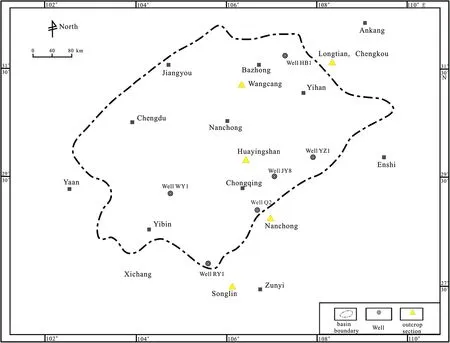
Fig.1 The sample location of outcrop sections and wells in Sichuan basin and adjacent areas

Table 1 Geochemical characteristics of samples studied

Fig.2 Zoogloea fossils in source rocks collected from South China.a Shale in Longtan Formation in Huayingshan;b siliceous limestone in Well Qian 2,Longtan Formation;c Lower Cambrian ZB19 carbonaceous shale in Chengkou,Sichuan;d modern activated sludge

Fig.3 Zoogloea fossils in the Permian strata in South China.a Black shale in Well Heba 1(P2d);b calciferous siliceous rock from Cangwang section,Sichuan(P2w);c gangue from Huayingshan section(P2l);d silty mudstone from Huayingshan section(P2l)
3 Results
In consideration of above mentioned specimen preparation process,contamination is regarded as non-existent in our specimens.Thus,bacterial fossils discussed in this paper were inherited from geological times.For the sake of prudence,we divided the observed bacterial fossils into con firmed and possible bacterial fossils.The con firmed bacterial fossils are characterized by:(1)suspected zoogloea identified on the thin sections of the source rocks;(2)bacterial fossil communities observed under SEM;(3)bacterial biomarkers detected by using GC–MS.We also found a number of microfossils comparable with bacteria in morphology and size,which were deemed as possible bacterial fossils due to only SEM data obtained in those high-mature source rock samples.
3.1 Thin sections
Due to genetic characteristics,some bacterial cells arranged in a special way,and were embedded with an extracellular matrix,so that they were well preserved and protected from devouring by other micro-animals.Generally,the suspected zoogloea fossils observed in low-mature source rocks(Ro<1.5%)exist in the aggregated form with blurry bacterial cells(Fig.2),due to low-resolution of light microscopes.The zoogloeas found in the Permian source rock are spherical,mushroom-like,oval,branched,filamentous or irregular(Fig.2a,b),similar to those found in modern activated sludge(Fig.2d).The zoogloeas were also in the Permian mudstone and coal seams(Fig.3).Additionally,the zoogloea fossils were found in the Lower Cambrian carbonaceous shales in Chengkou,Sichuan(Fig.2c).However,no zoogloea fossils were observed in the Lower Cambrian Niutitang Formation in Songlin or the Longmaxi Formation in Huayingshan.This may be the result that the source rocks are highly mature so that the zoogloea disappeared in the process of hydrocarbon generation.
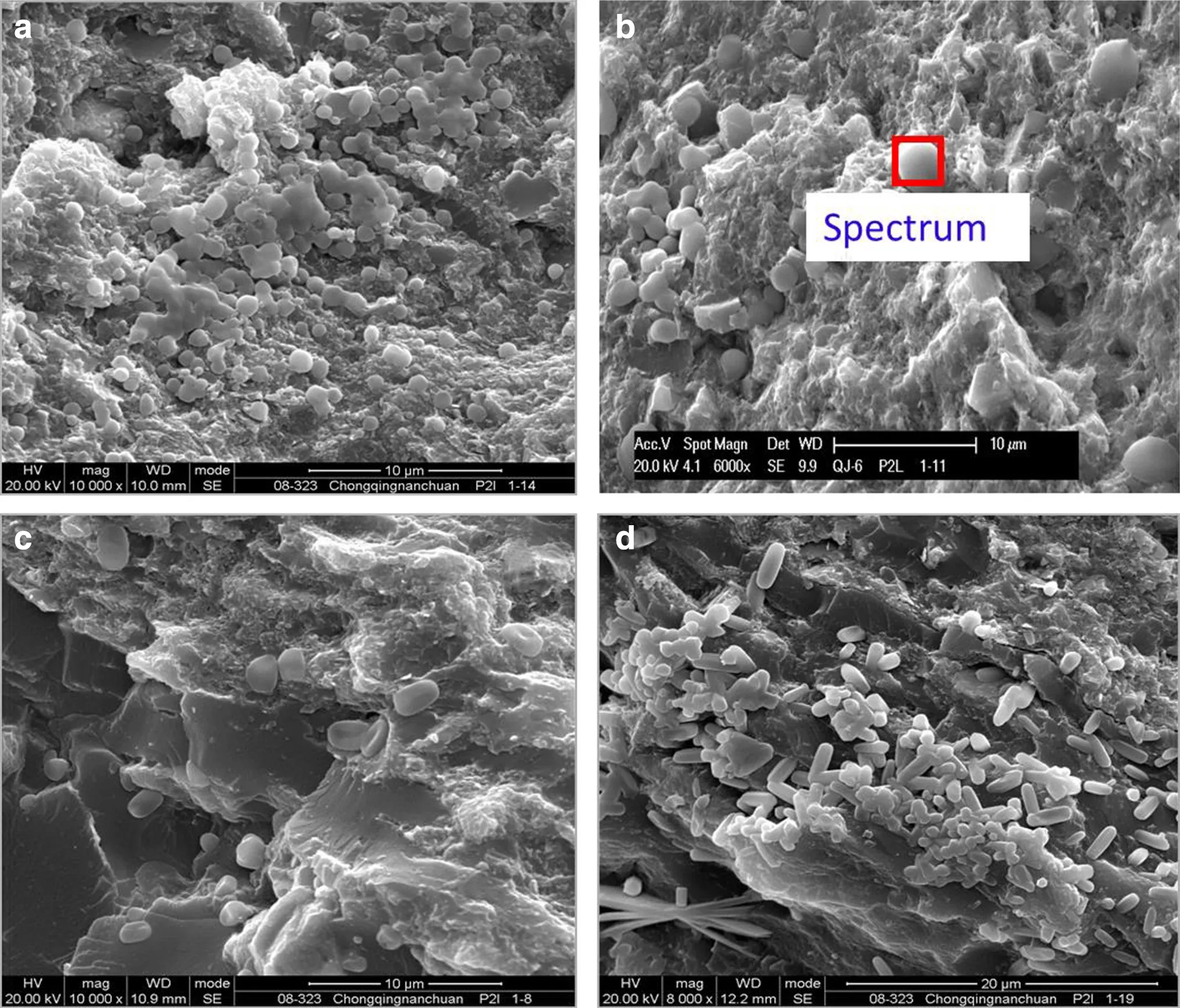
Fig.4 Bacterial fossils in the Permian Longtan Formation,Nanchuan,Chongqing

Table 2 Characteristics of element compositions in Spectrum 1(%)
3.2 SEM
In order to prove that the bacterial fossils found are original rather than contaminants or minerals,SEM was also used to further observe the micro structures of the source rocks.Moreover,energy spectrum and biomarker compositions of some samples were also analyzed.
3.2.1 The Permian source rocks

Fig.5 Possible bacterial fossils in the interspersed siliceous vein from the Permian Longtan Formation,Nanchuan,Chongqing
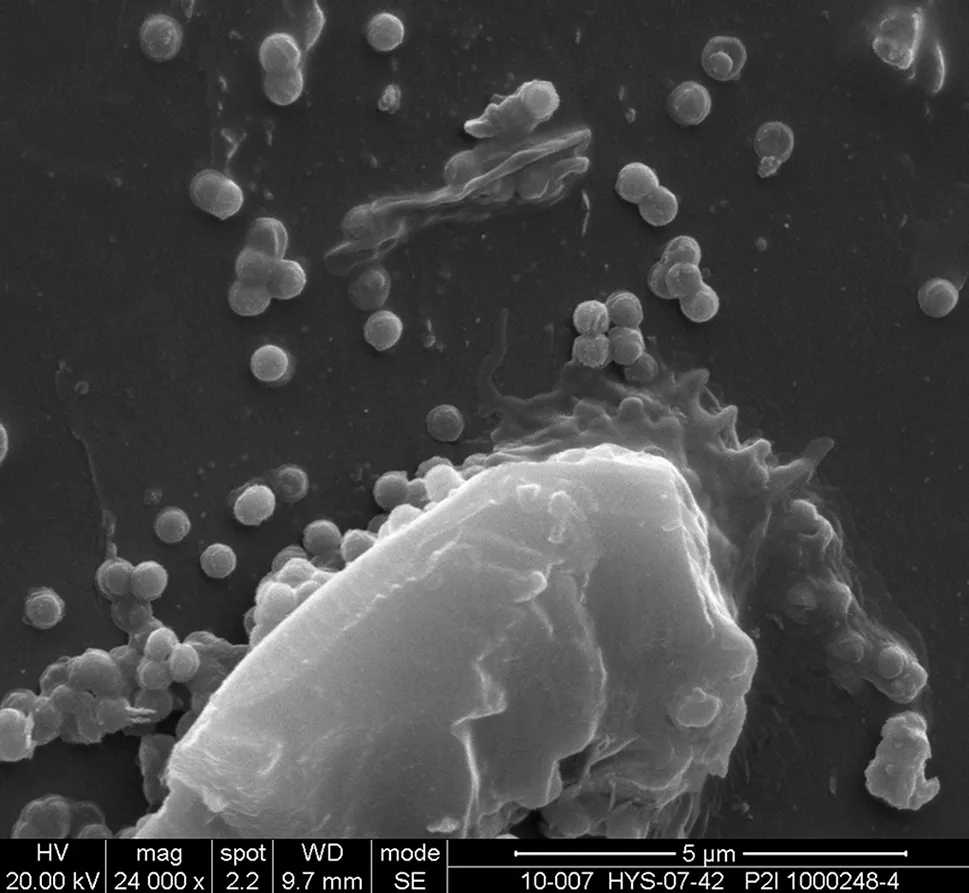
Fig.6 Nanoscale bacterial fossils in the rock sample of Huayingshan Longtan Formation,Chongqing
Abundant bacterial fossils were found in the thin sections of the siliceous limestone from Well Qian 2(the Upper Permian Longtan Formation) (Fig.2b), Nanchuan,Chongqing(Fig.4).The bacteria fossil communities were distributed in a variety of forms.Some were oblate(Fig.4c),and others were spherical,rod-or bar-shaped,with flattened characteristics and distinguished concave and convex sides on some communities(Fig.4d).These bacteria occurring in different parts of the rocks may present different bacterial species,or variations of the same bacterial species.Some bacterial fossils in local Longtan Formation,Nanchuan,were symbiotic with gypsum crystals(Fig.4a),indicating that the formation of gypsum might have a certain relationship with bacterial fossils,and the symbiotic bacteria might belong to sulfur bacteria(Edwards et al.2006),which was con firmed through further spectrum analysis(Fig.4b;Table 2).In general,chemoorganotrophic sulfur bacteria exist in aerobic environment with poor organic matter.However,the bacterial fossils found in this study were preserved in the source rocks with high organic matter abundance.Therefore,we suggested that the symbiotic bacteria may be anaerobic photoorganotrophic sulfur bacteria,mostly inhabiting in hydrogen sulfide-containing anaerobic waters and using the hydrogen from sul fi de hydrogen as an electron donor to reduce carbon dioxide.
Additionally,spherical bacterial fossil with individual diameter below 1 μm were observed and some were in a split reproductive state in the interspersed siliceous vein from the Permian Longtan Formation,Nanchuan,and Chongqing(Fig.5).Moreover,possible nanoscale bacterial fossils were found in the Huayingshan section(Fig.6),which however were greatly different in size from that in the Longtan Formation(Figs.5,6).
3.2.2 The Silurian source rocks
Possible bacterial fossils were also found in the kerogen of the Silurian Longmaxi Formation in Huayingshan,with length of 1.2–1.5 μm and diameter of ~0.6 μm,and located in the common size of bacteria(Fig.7).In addition,many rod-like bacterial particles were found in the samples,which were tightly bound to the kerogen and were not easily filtered during the treatment.In terms of the preserved morphology,these bacteria was fossilized and very different from the observation results of modern live bacteria under SEM.

Fig.7 Possible bacterial fossils in the kerogen of the Lower Silurian Longmaxi Formation,Huaying shan,Chongqing
3.2.3 The Cambrian source rocks
Evident bacterial polymorphism was found in Lower Cambrian ZB19 carbonaceous shale in Longtian,Chenkou(Figs.2c,8).The bacteria fossil communities were well preserved in rod or bar,and irregular shapes.Some bacteria were symbiotic with residues of linear leafed plants(Fig.9),which can be con fi rmed by the presence of biomarker-tricyclic diterpene(Fig.10).However,the higher plants have not been observed in the Cambrian system,and the reason that why tricyclic diterpene can be detected needs to be further studied.Moreover,hopanoids were also detected(Fig.10),indicating bacterial fossil present in the Cambrian carbonaceous shale.
Micro-phosphate nodules(~30 μm)were found in the Cambrian source rocks in Songlin,Guizhou.Filamentous bacteria(~1 μm)were located in these phosphate nodules and preserved in a growing state(Fig.11).Moreover,spore-like fossils were observed(Fig.12).Though these spore-like fossils were found elsewhere and not contaminated products(Lu et al.2001),they were considered to be possible bacterial fossils due to lack of other relative evidence(such as rock section photo and biomarker data).

Fig.8 Bacterial fossils in the Lower Cambrian carbonaceous shale of ZB19,Longtian,Chengkou
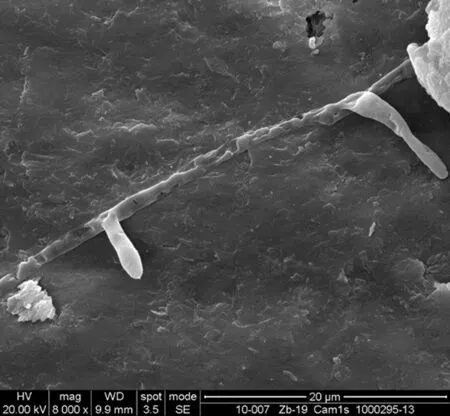
Fig.9 Symbiotic bacteria with the residues of linear leafed plants
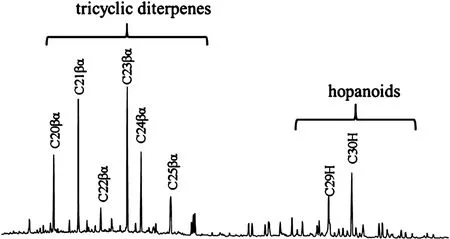
Fig.10 Gas chromatograms(m/z 191)showing tricyclic diterpenes and hopanoids in ZB19
4 Discussion
Previous studies have shown that bacterial fossils can be found in the Cambrian–Permian source rocks(Lei et al.1994;Edoardo and Maurice 2007;Wu et al.2007;Xie et al.2013;Zhao 2007;He et al.2010;Zheng 2013;Zhang et al.2015),especially in organic-rich source rocks and coal seams,which were con fi rmed by zoogloea observed on thin sections,SEM data and biomarker compounds.Possible bacterial fossils were identi fi ed only through SEM but without other evidences,due to the high maturity characteristics of samples.However,some specialists considered that the zoogloea was more like degraded organic matter,which we cannot tell what it was before.Though bacterial fossil communities were observed under SEM,the biggest problem is that the SEM pictures cannot be related with the ones by microscope and the age of these fossils shown in SEM pictures couldn’t be measured.These fossils could be formed from any time after the rock was deposited.The study of determining the formation time of fossils in the SEM pictures would be focused in the future,but even so,previous studies have shown their relationship with the formation of hydrocarbon.

Fig.11 Phosphate nodules and inner fi lamentous bacteria in the Lower Cambrian rocks from Songlin

Fig.12 Bacterial spore-like fossils in the Cambrian rocks from Songlin,Guizhou:a,b The No.8 sample from Songlin,and c from Ref.Wang and Tao(2005)
Bacterial fossils are common in the Permian strata,where many scholars have found a large number of bacterial fossils(Edoardo and Maurice 2007;Wu et al.2007;He et al.2010).In South China,organic sulfur is prevalent in the Permian coal seams(Zheng 2013),in which the distribution characteristics and genesis of sulfur was also studied by Zhao(2007)and Lei et al.(1994)also observed bacterial fossils in the high-sulfur coal in Guiding Coal Mine,Guizhou Province as we did in Longtan Formation,Nanchuan.It is suggested that bacteria is not accidentally present in high-sulfur environment. However, the formation mechanism and environment of sulfur bacteria are still unknown and should be studied in details in the future.
There are few reports about bacterial fossils found in the Silurian strata,where samples were of high maturity.Edwards et al.(2006)performed a detailed analysis of the bacterial structure in kerogen samples,which could be reliable,due to any possible contamination avoided in the process of sample processing.Possible bacterial fossils were found in the kerogen of the Lower Silurian Longmaxi Formation,Huayingshan,Chongqing,indicating that bacterial fossils might be also possibly widespread in the Silurian strata.
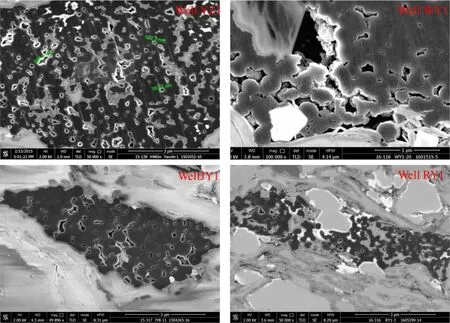
Fig.13 Pore formed by bacterial fossils in the Longmaxi Formation source rocks in South China
Pleomorphic bacterial fossils were found in the Cambrian strata,re fl ecting the diverse micro-environment in different micro-sections.Irregular bacterial community might be caused by their polymorphism,representing different species.Scholars found that many phenomena observed in phosphate nodules were related to the activities of microorganisms,the signi fi cant agent in the deposition of phosphorus.This provided strong evidence for the biomineralization of phosphate nodules(Lei et al.2000).Therefore,the formation of the phosphate nodules found in the Cambrian rock samples taken from Songlin,Guizhou,was possibly related to the activity of bacteria(Fig.11).In addition,the bacterial fossil found on the Songlin section(Fig.12)was similar to that was described by Edwards et al.(2006),with similar size,morphology and spore-like fossils.
The discovery of bacterial fossils in source rocks is important to the study on the formation and preservation of natural gas.First of all,it is signi fi cant to understand hydrocarbon generation.Havey et al.(1995)believed that bacterial degradation had an important impact on hydrocarbon generation through experimental simulation,even as important as the composition of original organic matter.Ding et al.(1997)studied the organic petrology of source rocks in the Junggar Basin and found a lot of amorphous bodies degraded by bacteria,which were the products of degradation of organic matter by bacteria and disproportionation reaction.Because bacteria participated in the transformation of organic matter,hydrocarbon generation potential of the source rocks was improved,and a lot of oil and gaswould beproducedin low maturestage(Ro=0.5%–0.7%)(Wang et al.1995).Zhang et al.(1996)investigated the characteristics of gas,oil and kerogen through Chlorella simulation before and after the degradation of bacteria,indicating that the pyrolysis rate of Chlorella increased by 2.09 times after the degradation of bacteria.Since bacterial fossils were commonly found in the source rocks in South China,they could have a great contribution to the formation of oil and gas at the early stage of hydrocarbon generation.We have also found the contribution of bacterial fossils to reservoir space(Fig.13).Based on previous analysis of the morphology and size of bacterial fossils,pore development in the bacterial fossils was observed using Argon ion laser and SEM.The nanoscale pores developed in these bacterial fossils were generally greater than 100 nm and locally connectable,providing primary space to shale gas.
In summary,we suggest that bacteria is important for shale gas generation and preservation,and different types of bacterial fossils might indicate different microbial sources,sedimentary environments and preservation mechanisms.However,a lot of future work on the relationship between bacterial fossils and the formation of source rocks,favorable sedimentary environment and the mineralization mechanism of bacterial fossils,needs to be done.By virtue of study on bacterial fossils,source rock evaluation will be triggered from micro to macro scale.Further understanding of the mysterious microscope world will provide theoretical support to the progress in exploration and development theory.
5 Conclusions
1. Con firmed and/or possible bacterial fossils are commonly found in marine source rocks in South China,and they have a symbiotic relationship with the source rocks.Bacterial fossils have been con fi rmed in lowmature samples taken from the Upper Permian Longtan Formation in Huayingshan and the Lower Cambrian Niutitang Formation in Chengkou,using thin sections,SEM and GC/MS analysis.The possible bacterial fossils may exist in the high-mature Lower Cambrian Niutitang Formation in Songlin and the Lower Silurian Longtan Formation in Huayingshan.
2. Bacteria in different marine source rocks have different characteristics,such as sulfur bacteria in coal seams and symbiotic with gypsum playing an important role in the formation of the gypsum.Bacterial fossils might also play an important role in the generation and preservation of hydrocarbons,which can improve hydrocarbon generation rate and provide reservoir space.
AcknowledgementThis work was supported by Petrochemical Fund(B)for ‘‘Research on the effect of gas containing indigenous organic matter in the Paleozoic shale’’(No.U1663202).
Arning ET,Birgel D,Brunne B,Peckmann J(2009)Bacterial formation of phosphatic laminites off Peru.Geobiology 7(3):295–307
Bailey JV,Joye SB,Kalanetra KM,Flood BE et al(2007)Evidence of giant sulphur bacteria in Neoproterozoic phosphorites.Nature 445(7124):198–201
Berndmeyer C,Birgel D,Brunner B,Wehrmann LM et al(2012)The in fl uence of bacterial activity on phosphorite formation in the Miocene Monterey Formation,California.Palaeogeogr Palaeoclimatol Palaeoecol 317(5):171–181
Delong EF,Pace NR(2001)Environmental diversity of bacteria and archaea.Syst Biol 50(4):470–478
Ding AA,Hui RY,Xia YQ(1997)The formation of type-D bacteridecompamorphinite and its hydrocarbon generating pattern.Chin J Geol 32(2):221–228
Edoardo P,Maurice T(2007)Bacterial fossils and microbial dolomite in Triassic stromatolites.Geology 35(3):207–210
Edwards D,Axe L,Parkes J,Richard D(2006)Provenance and age of bacteria-like structures on mid-Palaeozoic plant fossils.Int J Astrobiol 5(2):109–142
Eric EH,Peir KP,Cole TE(2015)Sedimentary phosphate and associated fossil bacteria in a Paleoproterozoic tidal fl at in the 1.85 Ga Michigamme Formation,Michigan,USA.Sediment Geol 319:24–39
Glenn CR,Arthur MA (1988)Petrology and major element geochemistry of Peru margin phosphorites and associated diagenetic minerals:authigenesis in modern organic rich sediments.Mar Geol 80(88):231–267
Guo XS,Hu DF,Wen ZD et al(2014)Major factors controlling the accumulation and high productivity in marine shale gas in the Lower Paleozoic of Sichuan basin and its periphery:a case study of the Wufeng–Longmaxi formation of Jiaoshiba area.Geol China 41(3):893–901
Havey HR,Tuttle JH,Bell JT(1995)Kinetics of phytoplankton decay during simulated sedimentation:changes in biochemical composition and microbial activity under oxic and anoxic conditions.Geochim Cosmochim Acta 59(16):3367–3377
He L,Wang YB,Yang H et al(2010)Palaeogeography and microfacies characteristics of microbialites across the Permian–Triassic Boundary in South China.J Palaeogeogr 12(2):151–163
Lei JJ,Ren DY,Tang YG et al(1994)Ultra-high organic sulfur coal sulfur accumulation mode in guiding.Chin Sci Bull 39(15):1405–1408
Lei JJ,Li RW,Cao J(2000)The characteristics of black shale-hosted concretionary phosphates precipitation in the early Cambrian horizon on Yangtze platform.Sci Geol Sin 35(3):277–287
Liang DG,Guo TL,Chen JP et al(2008)Distribution of four suits of regional marine source rocks.Mar Orig Pet Geol 13(2):1–16
Liu SG,Sun W,Song JM et al(2015)Tectonics-controlled distribution of marine petroleum accumulations in the Sichuan Basin,China.Earth Sci Front 22(3):146–160
Lu YR,Zhang FE,Yan BR et al(2001)Mechanism of karst development in sulphate rocks and its main geo-environmental impacts.Acta Geosci Sin 23(1):1–6
Ma YS(2007)Generation mechanism of Puguang gas field in Sichuan basin.Acta Pet Sin 28(2):9–21
Ma YS,Cai XY,Zhao PR et al(2010)Distribution and further exploration of the large-medium sized gas fields in Sichuan basin.Acta Pet Sin 31(3):347–354
Rao VP,Nai RR(1988)Microbial origin of the phosphorites of the western continental shelf of India.Mar Geol 84(1–2):105–110
Reimers CE,Ruttenberg KC,Can fi eld DE et al(1996)Porewater pH and authigenic phases in the uppermost sediments of the Santa Barbara Basin.Geochim Cosmochim Acta 60(21):4037–4057
Schopf JW(1994)Disparate rates,differing fates:tempo and mode of evolution changed from the Precambrian to the Phanerozoic.Proc Natl Acad Sci USA 91:6735–6742
Soudry D,Champetier Y(1983)Microbial processes in the Negev phosphorites(southern Israel).Sedimentology 30(3):411–423
Soudry D,Lewy Z(1988)Microbially in fluenced formation of phosphate nodules and megafossil moulds(Negev,southern Israel).Palaeogeogr Palaeoclimatol Palaeoecol 64(88):15–34
Wang WC,Tao MX(2005)Geomicrobial processes and petroleum resources.Geol Bull China 24(10–11):1022–1026
Wang TG,Zhong NN,Hou DJ et al(1995)The effects of bacteria on hydrocarbon generation mechanism in Banqiao sag.Sci China,Ser B 25(8):883–889
Wang JS,Wang YB,Li Q(2007)Potential relationship between extremophiles and hydrocarbon resources in marine extreme environment.Earth Sci J China Univ Geosci 32(6):781–788
Westall F(1999)The nature of fossil bacteria:a guide to the search for extraterrestrial life.J Geophys Res 104(E7):16437–16451
Wu YS,Jiang HX,Yang W et al(2007)Microbes and microbial rock in hypoxic environment between Permian and Triassic.Sci China(Ser D)37(5):618–628
Xie XM,Tenger G,JZ Qin et al(2013)Bactera-like fossil in the Early Cambrian siliceous shale from Zunyi,Guizhou,SW China.Acta Geol Sin 87(1):20–28
Yang H,Wang YB,Chen L et al(2007)Calci-microbialite as a kind of potential hydrocarbon source rock and its geomicrobiological processes.Earth Sci J China Univ Geosci 32(6):797–802
Zhang SC,Lu SN(1993)Molecular fossils derived from marine palaeobacteria.Earth Sci J China Univ Geosci 18(4):381–392
Zhang B,Wu QY,Sheng GY et al(1996)Gas,oil and Kerogen-like material generated by pyrolysis of chlorella before and after bacterial degradation.Geochimica 25(2):105–111
Zhang TS,Wu KY,Yang Y et al(2015)Evidence of microbial origin of organic matters of Niutitang shale gas reservoir.J Southwest Pet Univ(Sci Technol Ed)37(2):1–10
Zhao FP(2007)Cause and distribution of sulphurous content of the LatePermian coalin Guizhou Province.CoalConvers 30(3):16–20
Zheng JJ(2013)Sedimentary environment and coal accumulation pattern of the Late Permian low sulfur coal in Guizhou.Coal Geol China 25(6):16–20
杂志排行
Acta Geochimica的其它文章
- Heterogeneous Mg isotopic composition of the early Carboniferous limestone:implications for carbonate as a seawater archive
- Diffusion in garnet:a review
- Genesis of tuff interval and its uranium enrichment in Upper Triassic of Ordos Basin,NW China
- Constraints of molybdenite Re–Os and scheelite Sm–Nd ages on mineralization time of the Kukaazi Pb–Zn–Cu–W deposit,Western Kunlun,NW China
- An experimental study of interaction between pure water and alkaline feldspar at high temperatures and pressures
- Timing of mineralization at the Shihu gold deposit in the middle segment of the Taihang Mountain,China
